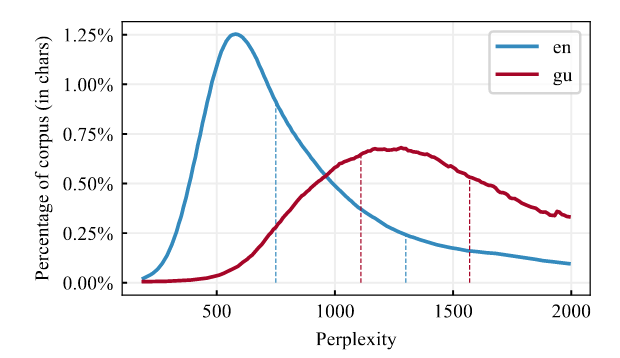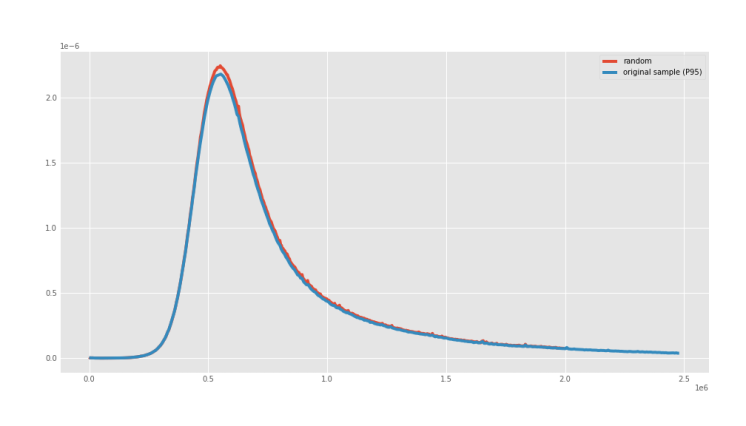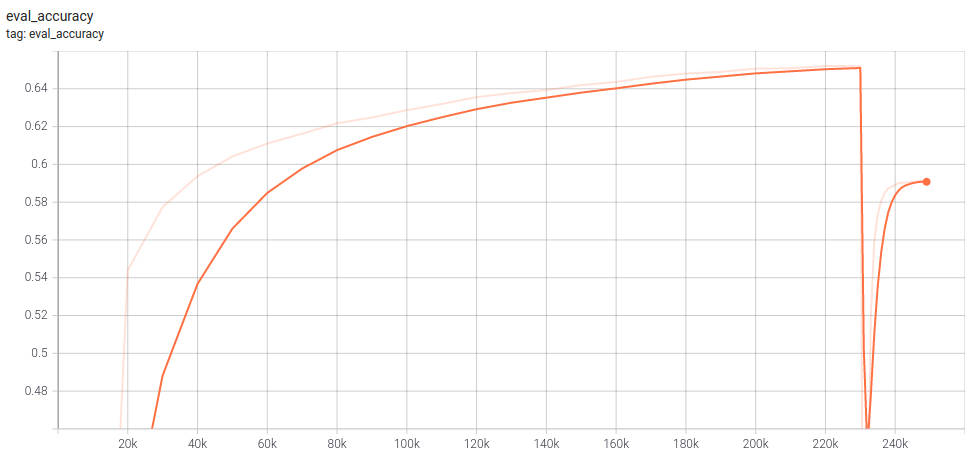language: es
license: CC-BY 4.0
tags:
- spanish
- roberta
pipeline_tag: fill-mask
widget:
- text: Fui a la librería a comprar un <mask>.
- Version 1 (beta): July 15th, 2021
- Version 1: July 19th, 2021
BERTIN
BERTIN is a series of BERT-based models for Spanish. The current model hub points to the best of all RoBERTa-base models trained from scratch on the Spanish portion of mC4 using Flax. All code and scripts are included.
This is part of the Flax/Jax Community Week, organized by HuggingFace and TPU usage sponsored by Google Cloud.
The aim of this project was to pre-train a RoBERTa-base model from scratch for during the Flax/JAX Community Event in which Google Cloud provided free TPUv3-8 to do the training using Huggingface's Flax implementations of their library.
Spanish mC4
mC4 is a multilingual variant of the C4, the Colossal, Cleaned version of Common Crawl's web crawl corpus. While C4 was used to train the T5 text-to-text Transformer models, mC4 comprises natural text in 101 languages drawn from the public Common Crawl web-scrape and was used to train mT5, the multilingual version of T5.
The Spanish portion of mC4 (mc4-es) contains about 416 million samples and 235 billion words in approximately 1TB of uncompressed data.
$ zcat c4/multilingual/c4-es*.tfrecord*.json.gz | wc -l
416057992
$ zcat c4/multilingual/c4-es*.tfrecord-*.json.gz | jq -r '.text | split(" ") | length' | paste -s -d+ - | bc
235303687795
Perplexity sampling
The large amount of text in mC4-es makes training a language model within the time constraints of the Flax/JAX Community Event by HuggingFace problematic. This motivated the exploration of sampling methods, with the goal of creating a subset of the dataset that allows well-performing training with roughly one eighth of the data (~50M samples) and in approximately half the training steps.
In order to efficiently build this subset of data, we decided to leverage a technique we call perplexity sampling and whose origin can be traced to the construction of CCNet (Wenzek et al., 2020) and their work extracting high quality monolingual datasets from web-crawl data. In their work, they suggest the possibility of applying fast language-models trained on high-quality data such as Wikipedia to filter out texts that deviate too much from correct expressions of a language (see Figure 1). They also released Kneser-Ney models for 100 languages (Spanish included) as implemented in the KenLM library (Heafield, 2011) and trained on their respective Wikipedias.
In this work, we tested the hypothesis that perplexity sampling might help reduce training-data size and training times.
Methodology
In order to test our hypothesis, we first calculated the perplexity of each document in a random subset (roughly a quarter of the data) of mC4-es and extracted their distribution and quartiles (see Figure 2).
With the extracted perplexity percentiles, we created two functions to oversample the central quartiles with the idea of biasing against samples that are either too small (short, repetitive texts) or too long (potentially poor quality) (see Figure 3).
The first function is a Stepwise that simply oversamples the central quartiles using quartile boundaries and a factor for the desired sampling frequency for each quartile, obviously given larger frequencies for middle quartiles (oversampling Q2, Q3, subsampling Q1, Q4).
The second function was a Gaussian approximation of the Stepwise function to smooth out the sharp boundaries and give a better approximation of the underlying distribution (see Figure 4).
We adjusted the factor parameter of the Stepwise function, and the factor and width parameter of the Gaussian function to roughly be able to sample 50M samples from the 416M in mc4-es (see Figure 4). For comparison, we also sampled randomly mC4-es up to 50M samples as well. In terms of sizes, we went down from 1TB of data to ~200GB.
Figure 5 shows the perplexity distributions of the 50M subsets for each of the approximations. All subsets can be easily accessed for reproducibility purposes using the bertin-project/mc4-es-sampled dataset. Since the validation set was too small to extract a 10% (5M) of the samples using perplexity-sampling with the same factor and width, in our experiments we decided to sample from the training sets. In the bertin-project/mc4-es-sampled dataset, the validation set pulls the samples from the original mc4.
from datasets import load_dataset
for split in ("random", "stepwise", "gaussian"):
mc4es = load_dataset(
"bertin-project/mc4-es-sampled",
"train",
split=split,
streaming=True
).shuffle(buffer_size=1000)
for sample in mc4es:
print(split, sample)
break
Random sampling displayed the same perplexity distribution of the underlying true distribution, as can be seen in Figure 6.
We then used the same setup as Liu et al. (2019) but trained only for half the steps (250k) on a sequence length of 128. In particular, Gaussian trained for the 250k steps, while Random was stopped at 230k and Stepwise at 180k (this was a decision based on an analysis of training performance and the computational resources available at the time).
Then, we continued training the most promising model for a few steps (~25k) more on sequence length 512. We tried two strategies for this, since it is not easy to find clear details about this change in the literature.
For Random sampling we trained with seq len 512 during the last 20 steps of the 250 training steps, keeping the optimizer state intact. Results for this are underwhelming, as seen in Figure 7:
For Gaussian sampling we started a new optimizer after 230 steps with 128 seq len, using a short warmup interval. Results are much better (we do not have a graph since training needed to be restarted several times).
Results
Our first test, tagged beta in this repository, refers to an initial experiment using Stepwise on 128 sequence lengths but a small factor to oversample everything. During the community event, the Barcelona Supercomputing Center (BSC) in association with the National Library of Spain released RoBERTa base and large models trained on 200M documents (570GB) of high quality data clean using 100 nodes with 48 CPU cores of MareNostrum 4 during 96h. At the end of the process they were left with 2TB of clean data at the document level that were further cleaned up to the final 570GB. In all our experiments and procedures, we had access to 3xTPUv3-8 for 10 days to do cleaning, sampling, taining, and evaluation. The BSC team evaluated our early release of the model beta and the results can be seen in Table 1.
Our final models were trained on a different number of steps and sequence lengths and achieve different—higher—masked-word prediction accuracies. Despite these limitations it is interesting to see the results they obtained using the early version of our model. Note that some of the datasets used for evaluation by BSC are not freely available, therefore it is not possible to verify the figures.
| Dataset | Metric | RoBERTa-b | RoBERTa-l | BETO | mBERT | BERTIN |
|---|---|---|---|---|---|---|
| UD-POS | F1 | 0.9907 | 0.9901 | 0.9900 | 0.9886 | 0.9904 |
| Conll-NER | F1 | 0.8851 | 0.8772 | 0.8759 | 0.8691 | 0.8627 |
| Capitel-POS | F1 | 0.9846 | 0.9851 | 0.9836 | 0.9839 | 0.9826 |
| Capitel-NER | F1 | 0.8959 | 0.8998 | 0.8771 | 0.8810 | 0.8741 |
| STS | Combined | 0.8423 | 0.8420 | 0.8216 | 0.8249 | 0.7822 |
| MLDoc | Accuracy | 0.9595 | 0.9600 | 0.9650 | 0.9560 | 0.9673 |
| PAWS-X | F1 | 0.9035 | 0.9000 | 0.8915 | 0.9020 | 0.8820 |
| XNLI | Accuracy | 0.8016 | WiP | 0.8130 | 0.7876 | WiP |
We are currently in the process of applying our language models to downstream tasks.
SQUAD-es
Using sequence length 128 we have achieved exact match 50.96 and F1 68.74.
POS
| Model | Metric |
|---|---|
| bert-base-multilingual-cased | 0.9629 |
| dccuchile/bert-base-spanish-wwm-cased | 0.9642 |
| BSC-TeMU/roberta-base-bne | 0.9659 |
| flax-community/bertin-roberta-large-spanish | 0.9646 |
| bertin-project/bertin-roberta-base-spanish | 0.9638 |
| bertin-project/bertin-base-random | 0.9656 |
| bertin-project/bertin-base-stepwise | 0.9656 |
| bertin-project/bertin-base-gaussian | 0.9662 |
| bertin-project/bertin-base-random-exp-512seqlen | 0.9660 |
| bertin-project/bertin-base-gaussian-exp-512seqlen | 0.9662 |
Improve table 2 with details like number of epochs etc
Conclusions
With roughly 10 days worth of access to 3xTPUv3-8, we have achieved remarkable results surpassing previous state of the art in a few tasks, and even improving document classification on models trained in massive supercomputers with very large—private—and highly curated datasets.
The experience has been incredible and we feel this kind of events provide an amazing opportunity for small teams on low or non-existent budgets to learn how the big players in the field pre-train their models. The trade-off between learning and experimenting, and being beta-testers of libraries (Flax/JAX) and infrastructure (TPU VMs) is a marginal cost to pay compared to the benefits such access has to offer.
We hope our work will set the basis for more small teams playing and experimenting with language models training on small subsets of data with reduced training times, since the performance of our models is on par with those trained on big machines for longer times.
Team members
- Javier de la Rosa (versae)
- Eduardo González (edugp)
- Paulo Villegas (paulo)
- Pablo González de Prado (Pablogps)
- Manu Romero (mrm8488)
- María Grandury (mariagrandury)
Useful links
- Community Week timeline
- Community Week README
- Community Week thread
- Community Week channel
- Masked Language Modelling example scripts
- Model Repository
References
CCNet: Extracting High Quality Monolingual Datasets from Web Crawl Data, Guillaume Wenzek, Marie-Anne Lachaux, Alexis Conneau, Vishrav Chaudhary, Francisco Guzmán, Armand Joulin, Edouard Grave, Proceedings of the 12th Language Resources and Evaluation Conference (LREC), p. 4003-4012, May 2020.
Heafield, K. (2011). KenLM: faster and smaller language model queries. In Proceedings of the EMNLP2011 Sixth Workshop on Statistical Machine Translation.






